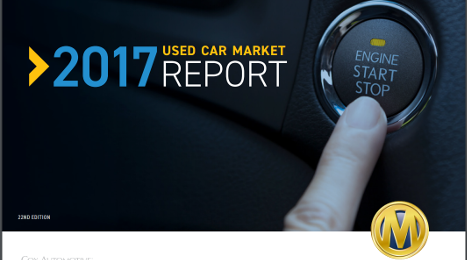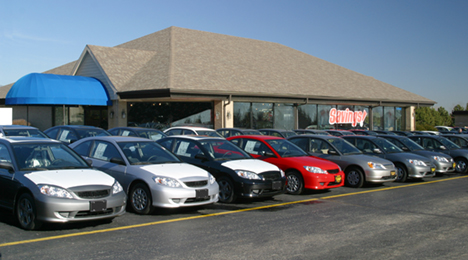On Tuesday, Black Book released its latest insights white paper titled, “Data Analytics: Critical for Driving Today’s Automotive Decisions.” Officials highlighted the paper offers an in-depth look at the role data analytics are now playing for automotive professionals and how they can be used to make more profitable business decisions.
Ever since the recession, Black Book pointed out that used-vehicle prices increased and stabilized at levels not seen in years, resulting in low depreciation rates. And while depreciation is finally beginning to accelerate, analysts noticed the stabilization of used-vehicle prices has been impacted by the industry’s increased use of data analytics.
Black Book said automotive decision-makers are going beyond vehicle pricing information to better understand data specifics that touch details found in seasonality, as well as regional considerations. This closer look at the data is helping to make more insightful decisions on everything from remarketing and pricing, to incentives and inventory levels.
The new Black Book white paper is geared to help automotive professionals ascertain a better understanding of the role data analytics are playing in the broader automotive industry, specific types of analytics being utilized, as well as individual examples of how data analytics are already being used to make smarter decisions.
In the white paper, Black Book details how data analytics is having an impact on three areas of automotive today:
—Gas prices and compact car values
—The impact ride-sharing vehicles have on vehicle depreciation
—The role “channel stuffing” plays on vehicle retention
The white paper also goes into detail about various types of analytics employed today, such as prescriptive and predictive analytics, data mining, text analytics, business intelligence and data visualization.
“What’s impressive today about data analytics is that the technology behind data is allowing us to provide an immense amount of customization and proprietary interpretation around the data to meet the needs of specific organizational goals,” said Anil Goyal, senior vice president of automotive valuation and analytics at Black Book.
“Combined with our ability to capture data in real-time, the analytics process is truly helping to fast-track intelligent decision-making environments in order to maximize profit potential and reduce losses,” Goyal continued.
Click here to download the white paper.
The white paper release arrived just days after Black Book rolled out its latest solution, Visual Analytics. Goyal explained the tool’s six main features in this report.
Cox Automotive insisted 2016 brought good news for almost every segment of the industry. Analysts pointed out that highlights included accelerating used-vehicle sales, a record-high 17.5 million new-vehicle sales and a growing number of services and support products that are dramatically improving the efficiency of the automotive marketplace — from retail to remarketing.
These trends — and the outlook for 2017 — are explored in depth in the 22nd edition of the Manheim Used Car Market Report, presented by Cox Automotive. Each year, the compilation provides a compelling snapshot of data and trends shaping the used-vehicle business.
“2016 was most likely a bullish year for you regardless of what sector of the automotive ecosystem you’re part of,” Cox Automotive chief economist Tom Webb said in a news release.
“Looking forward, although there is looming uncertainty about the economic climate in 2017, the prospects are still good that the seven-year recovery in the automotive industry will continue,” Webb added.
A major focus of this year’s report is the speed with which new technologies and services are transforming the automotive marketplace, a fact that Janet Barnard, Cox Automotive’s president of Inventory Solutions, addressed in her introductory letter.
“We’re committed to ensuring that doing business with us becomes faster, easier and more rewarding,” Barnard said. “We are creating a seamless experience to produce efficiencies and time savings across our portfolio of brands so our clients can focus on their customers and running their businesses.”
Cox Automotive mentioned the report is designed to provide a comprehensive look at multiple segments of the automotive industry, along with a series of brief case studies and insights from key industry players. Among the highlights:
Remarketing
• NAAA-member auction sales approached 10 million in 2016.
• Wholesale prices overall have been stable over the last four years despite rising volumes.
Dealers
• New-vehicle sales were a record 17.5 million units.
• Dealers increased used-vehicle sales for a seventh straight year.
Rental
• Total rental car industry revenue reached a record $28.4 billion.
• Number of vehicles purchased by rental companies increased 4 percent to 1.82 million in 2016.
Leasing
• New retail consumer lease originations grew 7 percent in 2016 to 4.4 million units.
• Off-lease volumes will reach a record 3.6 million in 2017 and then surpass 4 million in 2018.
Repossessions
• The dollar amount of auto loans outstanding reached a record level of $1.1 trillion.
• An estimated 1.7 million vehicles were repossessed in 2016.
Fleet
• New vehicle purchases by commercial and government fleets grew 6 percent in 2016.
• Fleet management companies continued to be innovative users of data analytics and remarketing best practices to protect residual values.
International
• Global new vehicle sales for 2016 are expected to grow to 90 million units.
• China ranked first in global new-vehicle sales with 25 million units sold, a 4.6-percent increase.
The report is available for download at www.manheim.com/consulting.
Editor's note: Watch for upcoming stories published by Auto Remarketing and SubPrime Auto Finance News containing more perspective from Webb.
As 2016 came to a close, RVI Group’s latest Market Update revealed that while used-car prices decreased in December compared to a year earlier, prices posted a slight uptick when compared to the prior month and making an economic adjustment.
The RVI Used Vehicle Price Index for December decreased by 0.2 percent when compared to November. And compared to a year ago, the index was down by 3.9 percent.
Adjusting for inflation, the index increased by 0.3 percent in December, and was down by 6 percent year-over-year.
RVI’s Used Vehicle Price Index, which started at 1.0 in January 2001, measures wholesale values of used cars 2 years old to 5 years old adjusted for mileage, mix and seasonality.
The index in December was at 1.065.
On a year-over-year basis, prices were down 6 percent in December.
Despite all segments running decline, pickup trucks continued to benefit from low gas prices and on a year-over-year basis performed better than the market average.
In December, RVI Group noted gas prices increased by 3 percent from the previous month.
Gas prices went from $2.30 per gallon in November to $2.37 in December.
Prices at the pump were up by 10.4 percent on a year-over-year basis.
Value retention for car segments is at a six-month high, according to Black Book, and the movement in one particular segment is proving to be “an encouraging sign.”
Overall, car segments saw a 0.39-percent depreciation rate last week, the company reported in the latest Black Book Market Insights report. It was at 0.43 percent for the four weeks prior.
And compact cars, in particular, have shown some uncharacteristic strength. Their values were down 0.19 percent last week, the second-lowest drop (percentage-wise) among car segments last week, according to Black Book.
The most significant decrease among cars was for the near-luxury car (down 0.68 percent) and the premium car segments (0.67 percent).
(The company’s data includes vehicles from model years 2008 through 2014.)
“Compact cars continued to hold their value for a second consecutive week; an encouraging sign after multiple years of sharp drops in retention values for this segment,” Anil Goyal, Black Book’s senior vice president of automotive valuation and analytics, said in the report.
Consider this: in January 2013, 2-year-old compact cars were retaining 63 percent of their MSRP.
Two-year-old compacts have seen their retention fall each year since, and this January, the retention rate is at 55 percent, Black Book said.
Which makes the wholesale price strength this month all the more impressive.
Turning to the truck side of the market last week, overall depreciation was at 0.51 percent. The prior four weeks, it was at 0.43 percent.
The heaviest decline for trucks was in the compact van segment (1.94 percent). The smallest decline was in the full-size luxury crossover/SUV (0.03 percent)
After climbing an average of 5 percent in the first quarters of the previous two years, used-car prices showed just 1-percent sequential growth in Q1 of 2016 — an “unusually low” amount, according to J.D. Power Valuation Services.
The December-to-March change this time around? Expect something right down the middle.
The company’s latest Guidelines report — which looks at vehicles up to eight years in age — said used-car prices in March should be up about 2.5 percent from where they were in December.
As far as how that plays out over the course of the year’s first three months, expect a 1-percent month-over-month decline in January followed by growth in the next two months.
Price growth in the first quarter is to be expected, as folks tend to receive tax refund checks, J.D. Power noted. Prices then back down as the market moves into spring.
This year, J.D. Power anticipates mainstream car prices will climb an average of 3.5 percent in the first quarter, the strongest gain of any segment (which is typical for Q1).
The firm forecasts a 3-percent rise in midsize van prices and a 2-percent rise (on average) in the price of mainstream utility vehicles.
Large pickup trucks and large utility vechiles are expected to see 1-percent gains. J.D. Power said such modest increases, again, are typical.
Luxury segments will vary; some are likely to see no change in price, while others will decline as much as approximately 2 percent. Like the trending in other segments, this reflects seasonal norms, according to J.D. Power. The most significant decline is expected to be in the luxury large car segment.
KAR Auction Services chief economist Tom Kontos used a term to describe December wholesale price moves that dealership personnel who have a military background might know from their days of basic training and daily marches.
According to ADESA Analytical Services’ monthly analysis of wholesale used-vehicle prices by vehicle model class, wholesale prices in December averaged $10,642, which was down 0.3 percent compared to November but up 3.9 percent relative to December of 2015.
Analysts determined truck prices — which fell 0.6 percent month-over-month — led the overall monthly decline, which they explained was consistent with rises in gasoline prices during the month that some dealers may have seen as a longer term trend.
“Wholesale prices did a bit of an about-face in December, as truck price softening, perhaps influenced by higher gasoline prices, drove down overall results,” Kontos said as a part of his monthly Kontos Kommentary, which also can be seen online here as well as the video window at the top of the page.
“New-vehicle incentive activity also remained high, which, along with higher fleet sales, helped the year close out with a new record in sales but put downward pressure on wholesale values,” he continued. “Fortunately, certified pre-owned used-vehicle sales also hit a new record, helping absorb growing used-vehicle supply and limiting the negative impact to wholesale prices.
“Particularly hard-hit were prices for full-size and luxury SUV/CUV models, as well as full-size vans,” Kontos went on to say. “Passenger car segments, on the other hand, registered price gains during the month, with only luxury and sporty cars (which tend to be less fuel-efficient) showing declines.
ADESA indicated average wholesale prices for used vehicles remarketed by manufacturers were down 4.2 percent month-over-month and down 0.4 percent year-over-year.
The company also noticed prices for fleet/lease consignors dropped by 1.5 percent sequentially but ticked up 1.0 percent on a year-over-year basis.
Analysts added that average prices in December for dealer consignors were flat versus November but 1.1 percent higher relative to December of 2015.
As previously reported by Auto Remarketing, Kontos also mentioned that December CPO sales were at record levels and were up 14.7 percent month-over-month and 2.4 percent year-over-year, according to figures from Autodata. For the year, CPO sales increased 3.5 percent, setting a new record at 2.64 million units.
Kontos closed with two other metrics.
Average new vehicle incentives were again above $3,000 and were nearly $1,000 higher than year-ago levels based on Edmunds data.
Fleet sales were up by 122,364 units and totaled almost 2.8 million in 2016, according to Bobit Business Media data. This helped total new-vehicle sales top the 2015 record of 17.5 million, as 2016 sales were up by 56,211, according to the Automotive News Data Center.
ADESA Wholesale Used-Vehicle Price Trends
| |
Average |
Price |
($/Unit) |
Latest |
Month Versus |
| |
Dec. 2016 |
Nov. 2016 |
Dec. 2015 |
Prior Month |
Prior Year |
| |
|
|
|
|
|
| Total All Vehicles |
$10,642 |
$10,672 |
$10,244 |
-0.3% |
3.9% |
| |
|
|
|
|
|
| Total Cars |
$8,576 |
$8,472 |
$8,629 |
1.2% |
–0.6% |
| Compact Car |
$6,413 |
$6,314 |
$6,535 |
1.6% |
-1.9% |
| Midsize Car |
$7,773 |
$7,446 |
$7,679 |
4.4% |
1.2% |
| Full-size Car |
$7,971 |
$7,656 |
$7,484 |
4.1% |
6.5% |
| Luxury Car |
$13,049 |
$13,182 |
$13,213 |
-1.0% |
-1.2% |
| Sporty Car |
$12,748 |
$13,064 |
$13,339 |
-2.4% |
-4.4% |
| |
|
|
|
|
|
| Total Trucks |
$12,645 |
$12,726 |
$11,942 |
-0.6% |
5.9% |
| Minivan |
$8,897 |
$8,623 |
$8,448 |
3.2% |
5.3% |
| Full-size Van |
$11,317 |
$12,320 |
$11,513 |
-8.1% |
-1.7% |
| Compact SUV/CUV |
$10,481 |
$10,439 |
$10,264 |
0.4% |
2.1% |
| Midsize SUV/CUV |
$11,336 |
$11,473 |
$10,284 |
-1.2% |
10.2% |
| Full-size SUV/CUV |
$14,379 |
$14,607 |
$12,603 |
-1.6% |
14.1% |
| Luxury SUV/CUV |
$18,141 |
$18,554 |
$17,925 |
-2.2% |
1.2% |
| Compact Pickup |
$8,757 |
$8,755 |
$8,229 |
0.0% |
6.4% |
| Full-size Pickup |
$15,624 |
$15,548 |
$14,825 |
0.5% |
5.4% |
Source: ADESA Analytical Services. November revised
While the price performance of compact cars caught the attention of editors this past week, Black Book personnel at the auction also noticed activity in the lanes picked up considerably during the second full week of 2017.
The latest Black Book Market Insights report showed compact cars retaining their values better than most segments last week. But out of all segments, editors determined it was the subcompact crossover that maintained and even increased in value.
“It is interesting to see that while compact cars did very well in holding value last week, sub-compact cars continued to experience sharp decline.” said Anil Goyal, senior vice president of automotive valuation and analytics at Black Book
Volume-weighted, editors indicated overall car segment values decreased by 0.41 percent last week; lower than the average depreciation rate of 0.51% seen in the previous four weeks.
Black Book determined prestige luxury car and subcompact car segments declined the most by 0.69 percent and 0.64 percent, respectively.
Volume-weighted, editors noted overall truck segment values — including pickups, SUVs and vans — decreased by 0.37 percent last week; lower than the average depreciation rate of 0.47 percent reported during the previous four weeks.
Editors added that prices in the full-size van and full-size luxury crossover/SUV segments declined the most — both by 1.04 percent.
As vehicle values changed, Black Book lane watchers noticed dealer bidding picked up in most places where reports surfaced.
The most activity evidently originated in California as representative said, “The market is good here with Utility Vehicles in highest demand,” while another observer added, “Prices held up well here today with many consignors having a good overall sales rate.”
In Arizona, a similar scene unfolded as Black Book reported, “Prices were higher here this week. A great start to the New Year.
And in Texas, “Attendance was up today compared to last week, and sales were strong.”
A couple of softer spots came from Tennessee as Black Book’s representative said, “Good selection of inventory here today but sales are still a little slow overall.” Up in Washington, it was sluggish, too, as the lane watcher said, “Tough sale here today with plenty of no-sales.”
Looking at information for the first full week of 2017, the newest Black Book Market Insights Report detailed steeper declines in value for several segments — with three in particular catching editors’ attention most.
Registering the most significant price drops last week were sporty cars, luxury cars and crossovers. Conversely, Black Book noticed compact vans have been able to retain their value “sufficiently” since last week.
“Smaller cars are back in demand at the start of the new year. We expect a good spring season this year for such vehicles. Sporty cars show higher declines due to seasonality,” said Anil Goyal, senior vice president of automotive valuation and analytics at Black Book.
Volume weighted, editors indicated overall car segment values decreased by 0.45 percent last week; lower than the average depreciation rate of 0.56 percent seen in the previous four weeks.
Prices in the sporty car, luxury car, premium sporty car and prestige luxury car segments declined the most by 0.87 percent, 0.72 percent, 0.72 percent and 0.71 percent, respectively.
Again, volume weighted, Black Book said overall truck segment values (including pickups, SUVs and vans) decreased by 0.51 percent last week; same as the average depreciation rate of 0.51 percent posted during the previous four weeks.
Editors found that the subcompact crossover, full-size crossover and midsize crossover segments declined the most by 1.36 percent, 0.88 percent and 0.85 percent, respectively.
Black Book representatives mingling in the lanes during the first week of the year focused on dealer mood when reporting back to headquarters
An auction watcher in Tennessee said, “Plenty of dealers here today but consignment was rather low.” A similar scene played out in Missouri as the representative said, “Low consignment today but buyers expect that to change in coming weeks.”
Trucks also another subject often relayed from Black Book representatives.
One in Michigan said, “Clean trucks are doing well but the rest of the market is weak,” as another in Pennsylvania added, “Average market trend here with most attention directed towards trucks.”
A couple of high points in the lanes occurred in Texas and Arizona.
The lane observer in the Lone Star State said, “The market is improving slightly with several consignors having a good day today,” while in Arizona it was a “steady sale today with prices on the high side for this time of year.”
A closing comment also came from Arizona as Black Book’s representative reported that, “Soft late model used sales around here. Used having to compete with new incentives.”
From at least a mathematician’s perspective, 2016 closed with Manheim noticing the least amount of volatility since the auction company created the Manheim Used Vehicle Value Index more than 20 years ago.
Manheim reported on Monday that wholesale used-vehicle prices (on a mix-, mileage-, and seasonally adjusted basis) increased by 0.2 percent in December, which brought the index reading to 124.9. The mark represented a decline of 0.6 percent from a year ago.
Cox Automotive chief economist Tom Webb combined both high-level math with other bits of analysis to explain why wholesale prices finished the year on that trend.
“Despite significant increases in auction volumes in 2016, wholesale pricing was firm. On an annual average basis, the Manheim Index was even able to eke out a small gain of 0.3 percent, the third increase in a row,” Webb said.
“The most notable aspect of wholesale pricing in recent years has been the stability,” he continued. “After a sharp rise in wholesale pricing in 2009 and 2010 coming out of the recession, the absolute year-over-year change in pricing was less than 2 percentage points in each of the last six years. Statistically speaking, this period has shown the least volatility in wholesale vehicle pricing since the Manheim Index’s inception in 1995.
“In addition to macro-economic and industry factors, this stability has been driven by better, and more efficient, remarketing practices that have enabled commercial consignors to anticipate, respond to, and, thus, minimize impending swings in wholesale pricing,” Webb said.
Looking deeper at price movements by vehicle segment, Manheim noticed pickups posted the only year-over-year price rise in December, moving up by 4.3 percent.
Prices for units in four other segments softened year-over-year in December as Manheim reported declines for luxury cars (down 0.8 percent), SUVs and CUVs (down 1.2 percent), midsize cars (down 3.7 percent) and compact cars (down 5.3 percent).
As for vans, Manheim said prices for those units remained unchanged in December when compared to a year earlier.
“Although overall wholesale prices have been very stable of late (a movement of only 1.2 percent over the past four years), the differences between market classes have been pronounced,” Webb said. “At the extremes, adjusted wholesale prices for pickups have risen 28 percent during this period, while compact car values fell 14 percent.
“Blame it on the tremendous consumer preference shift toward crossovers and away from small sedans,” he continued. “On the new-vehicle side, flexible production capacity enabled manufacturers to better adjust to this shift than in past cycles.
“As a result, the share of new-vehicle sales accounted for by ‘trucks’ was more than 60 percent in 2016, up from only 45 percent in 2009,” Webb added.
So what do those trends mean for smaller units?
“Of course, the ‘production of used vehicles’ (i.e., past new-vehicle sales) can’t be adjusted,” Webb said. “As a result, the supply of used compact cars has been higher than what consumers demanded in recent years, and as a consequence, residuals suffered.”
Editor’s note: Watch for upcoming reports this week from both Auto Remarketing and SubPrime Auto Finance News as Webb shared more insights about the current state of the market and what might happen later in 2017.
The average 12-month depreciation for vehicles from the 2011-2015 model years was 17.3 percent last year, according to Black Book, which said depreciation rates began to stabilize at the close of 2016.
Twelve-month depreciation for car segments was at 20 percent, with truck segments averaging 15.5 percent.
In the final month of the year, overall depreciation was at 2.4 percent. Trucks were at 2.3 percent and cars depreciated 2.7 percent.
“The depreciation rates for all cars and trucks followed seasonal patterns with higher depreciation in Q4,” Anil Goyal, senior vice president of automotive valuation and analytics, said in a news release.
“That being said, with the spring season around the corner, it will be interesting to see if smaller cars experience higher levels of seasonality lift, especially with the recent bump in gas prices.”
As it stands, the subcompact car, for instance, showed the second-highest level of depreciation in December (3.5 percent) and was among the highest for the full year (23.9 percent). Compact cars were in the middle of the pack for December at 2.3 percent depreciation, but had one of the higher full-year figures (20.5 percent).
Meanwhile, the top eight segments for retention in December included seven truck segments, according to Black Book.












